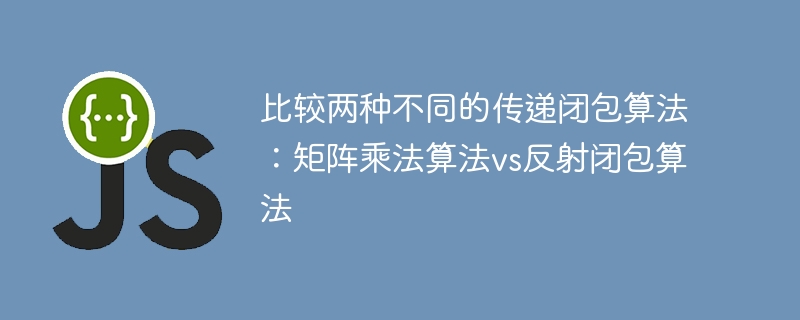

Compare two different transitive closure algorithms: matrix multiplication algorithm vs reflection closure algorithm
The transitive closure algorithm is used to find the transitive closure of a relationship, That is, all transitive relations on this relation. In computer science, there are many ways to implement the transitive closure algorithm. In this article, we will compare two common transitive closure algorithms: the matrix multiplication algorithm and the reflective closure algorithm. We will introduce the principles and code examples of each algorithm in detail, and compare them by performance and applicable scenarios.
Matrix multiplication algorithm:
The matrix multiplication algorithm is an efficient transitive closure algorithm, which uses matrix multiplication operations to calculate transitive closure. The main idea of this algorithm is to gradually calculate the transitive relationship between all pairs of nodes through iterative matrix multiplication. The specific steps are as follows:
The following is a code example of the matrix multiplication algorithm:
void transitiveClosureMatrix(int[][] graph, int n) {
int[][] tc = new int[n][n];
for(int i = 0; i < n; i++) {
for(int j = 0; j < n; j++) {
tc[i][j] = graph[i][j];
}
}
for(int k = 0; k < n; k++) {
for(int i = 0; i < n; i++) {
for(int j = 0; j < n; j++) {
tc[i][j] = (tc[i][j] != 0) || (tc[i][k] != 0 && tc[k][j] != 0) ? 1 : 0;
}
}
}
// 输出传递闭包
for(int i = 0; i < n; i++) {
for(int j = 0; j < n; j++) {
System.out.print(tc[i][j] + " ");
}
System.out.println();
}
} Reflective closure algorithm:
The reflective closure algorithm is another common transitive closure algorithm that utilizes Compute transitive closure recursively. The main idea of this algorithm is to find the direct transitive relationship of nodes and recursively find the indirect transitive relationship. The specific steps are as follows:
The following is a code example of the reflective closure algorithm:
void transitiveClosureReflexive(int[][] graph, int n) {
int[][] tc = new int[n][n];
for(int i = 0; i < n; i++) {
transitiveClosureReflexiveUtil(graph, tc, i, i, n);
}
// 输出传递闭包
for(int i = 0; i < n; i++) {
for(int j = 0; j < n; j++) {
System.out.print(tc[i][j] + " ");
}
System.out.println();
}
}
void transitiveClosureReflexiveUtil(int[][] graph, int[][] tc, int i, int j, int n) {
tc[i][j] = 1;
for(int k = 0; k < n; k++) {
if(graph[j][k] == 1 && tc[i][k] == 0) {
transitiveClosureReflexiveUtil(graph, tc, i, k, n);
}
}
}Comparison of performance and applicable scenarios:
Both the matrix multiplication algorithm and the reflective closure algorithm can be used to calculate transitive closure packages, but they have different performance and applicable scenarios. The time complexity of the matrix multiplication algorithm is O(n^3) and the space complexity is O(n^2), which is suitable for situations where the number of nodes is small. The time complexity of the reflection closure algorithm is O(n^2*m) and the space complexity is O(n^2), which is suitable for situations where the number of nodes is large but the relationships are sparse.
Summary:
Matrix multiplication algorithm and reflection closure algorithm are two common transitive closure algorithms. The matrix multiplication algorithm calculates the transitive closure through iterative matrix multiplication and is suitable for situations where the number of nodes is small. The reflective closure algorithm calculates the transitive closure in a recursive manner, which is suitable for situations where the number of nodes is large but the relationships are sparse. Choosing an appropriate algorithm based on the actual situation can improve calculation efficiency.
The above is the detailed content of Transitive closure algorithm comparing matrix multiplication algorithm and reflective closure algorithm. For more information, please follow other related articles on the PHP Chinese website!




